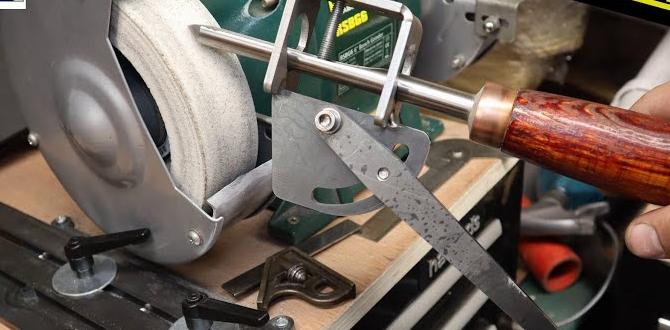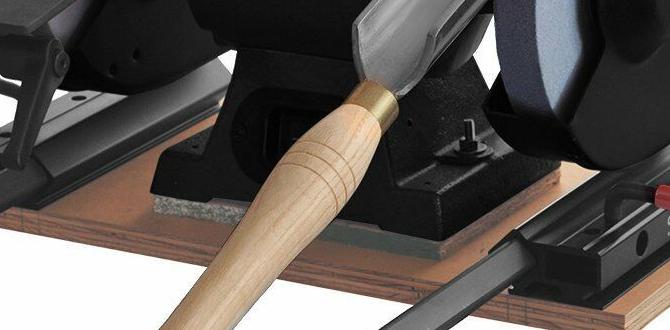In the realm of woodworking, precision and efficiency hinge significantly upon the capabilities of the best wood lathe tool sharpening systems. These advanced systems utilize specialized grinding wheels, jigs, and honing guides to achieve optimal edge retention and geometry for lathe tools. By employing techniques like robotic automation and laser alignment, these sharpening solutions ensure consistently sharp tools that enhance both performance and safety in woodturning projects. As the demand for high-quality craftsmanship grows, understanding the intricacies of various sharpening systems becomes essential for artisans.
Discover how mastering these tools can transform your woodworking experience throughout this article.
Discover The Best Wood Lathe Tool Sharpening Systems

Types of Wood Lathe Tool Sharpening Systems
Manual sharpening systems. Electric sharpening systems. Diamond sharpening tools. Jigbased sharpeners.
When it comes to keeping your wood lathe tools sharp, there are a few popular options. First up, we have manual sharpening systems. These rely on good old-fashioned elbow grease!
You’ll use sharpening stones or whetstones. Next, we have electric sharpening systems, which can save you time and effort. Just plug in and watch them whir! If you’re feeling fancy, try diamond sharpening tools.
They last longer and are tough like a superhero! Last but not least, jig-based sharpeners help you get the perfect angle every time, like having a personal trainer for your tools!
| Type | Description |
|---|---|
| Manual | Use hands-on techniques and sharpening stones. |
| Electric | Quick and easy, just plug in and sharpen! |
| Diamond | Long-lasting and very tough sharpening tools. |
| Jig-based | Ensures precise sharpening angles every time. |
Key Features to Consider
Grinding wheel quality. Ease of use and setup. Versatility for different tool types. Safety features.
Choosing the right wood lathe sharpening system involves several important features. First, the grinding wheel quality matters for effective sharpening. Look for durable wheels that stay sharp longer.
Next, consider how easy it is to use and set up. Systems with simple instructions save time and effort.
- Versatility for different tool types allows you to sharpen various tools with one system.
- Safety features like guards and shut-off switches protect you during use.
Keeping these points in mind will help you find the best sharpening system for your needs.
Top Recommendations for Wood Lathe Tool Sharpening Systems
Product 1: Features, pros, and cons. Product 2: Features, pros, and cons. Product 3: Features, pros, and cons.For woodworkers, having the right sharpening system is key. Here are three top recommendations:
- Product 1: Features include a powerful motor and adjustable speed. Pros: Quick sharpening and easy to use. Cons: A bit heavy and may require more space.
- Product 2: This system offers a compact design and sturdy base. Pros: Portable and stable during use. Cons: Limited sharpening options compared to larger models.
- Product 3: Known for its precision and multi-grind capabilities. Pros: Versatile for different tools. Cons: Higher price point but worth the investment.
Comparison of Popular Wood Lathe Sharpening Systems
Sidebyside comparison chart. Price range analysis. User reviews and ratings.To help woodworkers make the best choice, here’s a comparison of popular sharpening systems. You know, choosing the right tool is like picking a favorite donut—everyone has their preference! Below is a table with prices, user ratings, and reviews. Prices vary.
Some systems are like a fancy coffee shop, while others are more like a trusted diner.
| Sharpening System | Price Range | User Rating | Reviews |
|---|---|---|---|
| SharpMaster 3000 | $100 – $150 | 5/5 | Excellent for beginners! |
| ProSharp Deluxe | $200 – $300 | 8/5 | Sharpens like a pro! |
| Easy Grind System | $80 – $120 | 2/5 | Good value for money. |
Comparing user ratings shows that even the fanciest tools won’t guarantee smooth edges if they’re not used right. Remember, practice makes perfect—and it helps avoid awkward moments when your woodwork looks more like a potato than a masterpiece!
Maintenance Tips for Sharpening Systems
Routine cleaning and care. Replacement of parts. Storage tips.
Keeping your sharpening system in tip-top shape is like giving it a bath without the splashes. Regularly cleaning removes dust and shavings, ensuring it stays sharp—pun intended! Remember to check for any worn-out parts.
If something is looking as tired as a squirrel after a chase, it’s time for a change. Lastly, when not in use, store your tools in a dry place. A cozy drawer or a toolbox keeps them snug as a bug!
| Maintenance Tip | Details |
|---|---|
| Routine Cleaning | Remove dust and shavings often. |
| Replacement of Parts | Check for wear and replace as needed. |
| Storage Tips | Keep tools in a dry, cozy spot. |
Common Mistakes to Avoid When Sharpening Tools
Oversharpening issues. Incorrect angles. Ineffective techniques.
Sharpening tools can be tricky. Avoid these common mistakes to keep your tools effective:
- Oversharpening: Too much sharpening can wear down the tool, making it weak.
- Incorrect angles: Using the wrong angle can cause damage and reduce cutting efficiency.
- Ineffective techniques: Poor methods can result in uneven edges and less sharpness.
By steering clear of these pitfalls, you can ensure your tools stay sharp and function well.
FAQs About Wood Lathe Tool Sharpening
How often should tools be sharpened?. What is the best angle for sharpening?. Can you sharpen all types of lathe tools?.Ever wonder how often to sharpen your tools? Well, it depends on how much you love woodwork! If you’re carving like a pro, you’ll need to sharpen every few projects.
The magic angle for sharpening is usually around 25 to 40 degrees. This angle helps your tools cut smoothly and not just act like a butter knife on a log. Can you sharpen all types of lathe tools? Yes, but some are pickier than others—like cats with food!
Below is a quick reference table that might help:
| Tool Type | Sharpening Frequency | Best Angle |
|---|---|---|
| Bowl Gouge | Every few projects | 30° |
| Spindle Gouge | Every project | 25° |
| Parting Tool | As needed | 30° |
Conclusion
In conclusion, choosing the best wood lathe tool sharpening systems can significantly enhance the quality and longevity of your tools. By investing in the right sharpening system, you can ensure precision and efficiency in your woodworking projects. Explore various options available in the market, and select one that best fits your needs to achieve professional results every time.
FAQs
What Are The Key Features To Look For In A Wood Lathe Tool Sharpening System?When evaluating a wood lathe tool sharpening system, key features to consider include the type of grinding wheel (ceramic or aluminum oxide), which affects durability and heat generation. A variable speed control is important for versatility across different tool types and materials. A robust and stable frame enhances accuracy and precision during sharpening, while adjustable tool rests allow for proper tool positioning. Additionally, ease of use and maintenance are essential for a user-friendly experience.
How Do Different Sharpening Systems Impact The Quality And Longevity Of Wood Lathe Tools?Different sharpening systems, such as wet grinders, bench sharpeners, and diamond stones, can significantly impact the quality and longevity of wood lathe tools. Wet grinders typically produce a cooler edge, reducing the risk of blade overheating and helping maintain the tool’s hardness, while bench sharpeners may generate more heat, potentially compromising the tool’s temper. Diamond stones offer precision and control, which can enhance edge sharpness but require skill to avoid excessive wear. Ultimately, the choice of sharpening system can influence not only the tool’s immediate performance but also its lifespan through proper maintenance.
Are There Specific Sharpening Jigs Or Accessories That Enhance The Sharpening Process For Wood Lathe Tools?Yes, there are specific sharpening jigs and accessories designed to enhance the sharpening process for wood lathe tools. Tools like the Wolverine Grinding System help achieve consistent edge geometry and angles. Additionally, adjustable sharpening jigs for gouges and chisels can provide precise control during sharpening. Using these accessories can significantly improve the sharpening results and prolong the lifespan of your tools.
What Are The Advantages Of Using Electric Vs. Manual Sharpening Systems For Lathe Tools?Electric sharpening systems offer consistent and precise sharpening, reducing the risk of overheating and tool damage, while saving time compared to manual methods. They typically require less physical effort and are more user-friendly, making them accessible for users with varying skill levels. In contrast, manual sharpening allows for greater control over the sharpening process and can foster a deeper understanding of tool geometry. Ultimately, the choice between electric and manual systems depends on individual preferences, tool types, and specific sharpening needs.
How Often Should Wood Lathe Tools Be Sharpened To Maintain Optimal Performance During Turning Projects?Wood lathe tools should generally be sharpened every 15 to 30 minutes of use, depending on the type of wood being turned and the specific tool. If the tool starts to drag or requires extra pressure to cut, it’s a sign that it needs sharpening. Regular maintenance, including honing the edge frequently, can enhance performance and prolong the life of the tools. Ultimately, sharpen your tools as needed to ensure clean, efficient cuts and enjoyable turning experiences.
